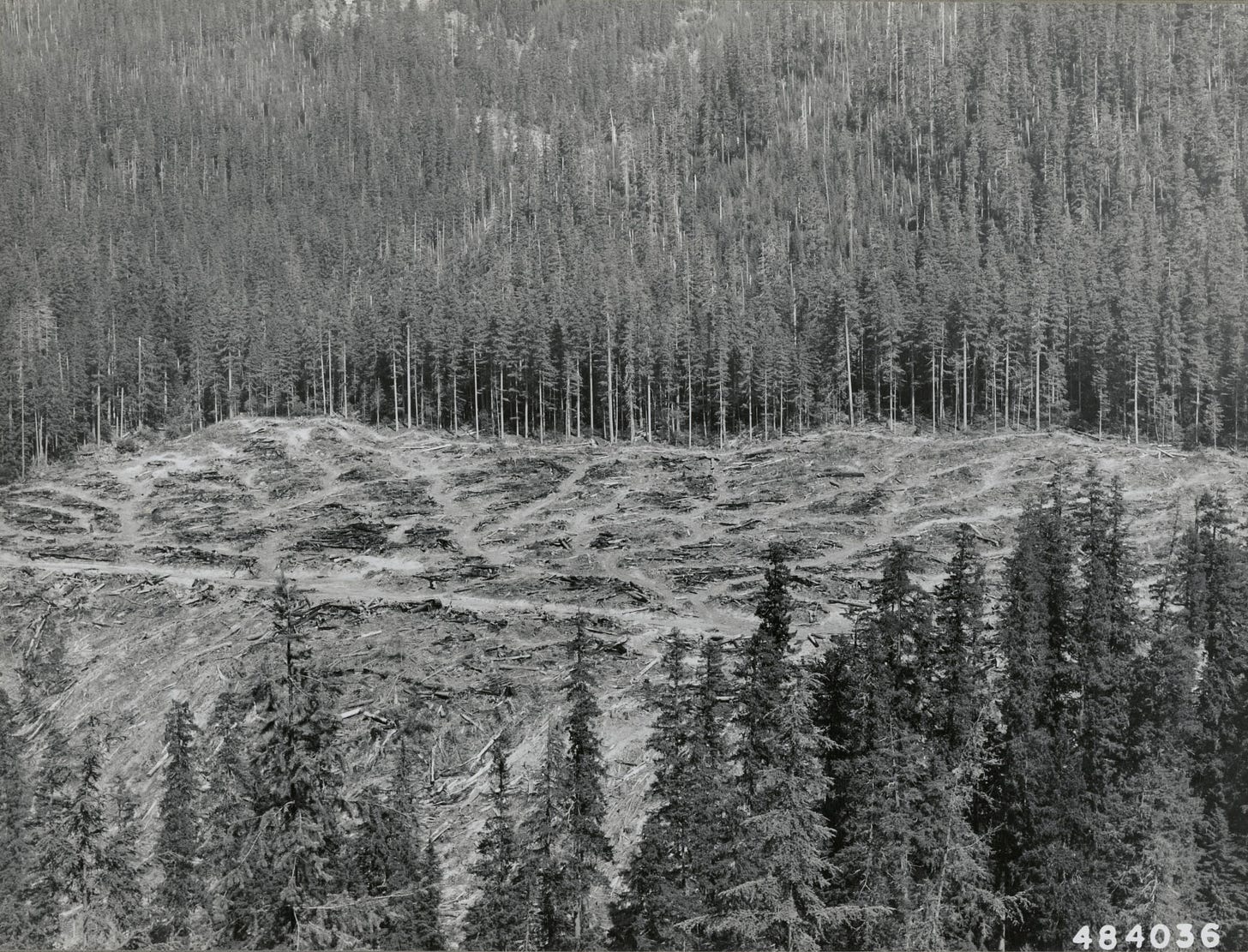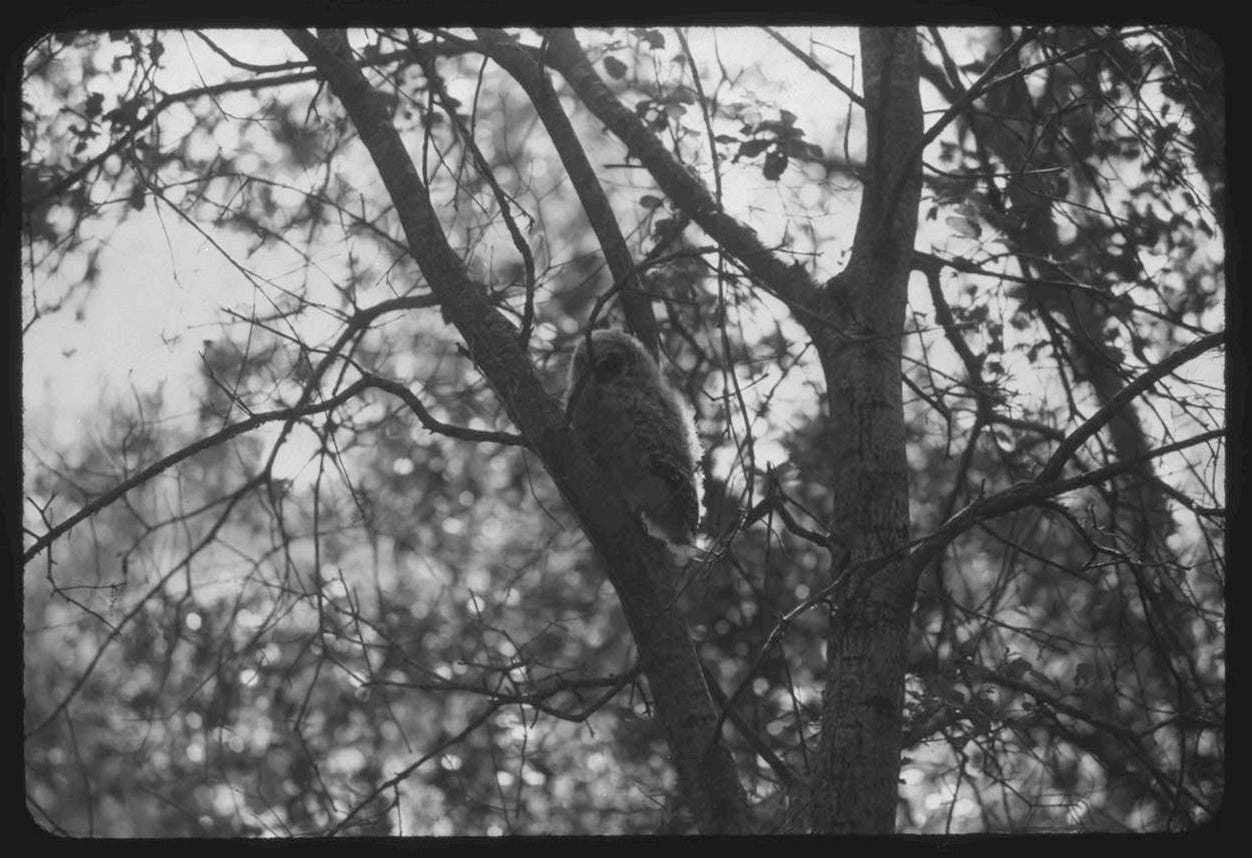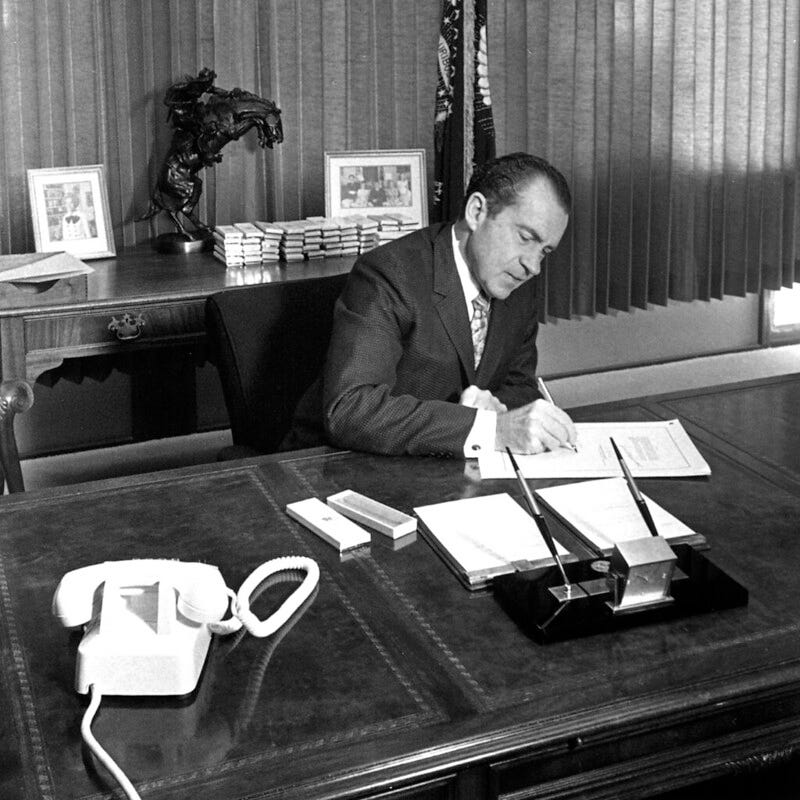How a Threatened Owl and a Judge Forced Federal Agencies to Follow the Law
Part of the Spotted Owl Saga as a Story of Democracy
Next month, I’m heading to a writing residency in the H. J. Andrews Experimental Forest. This is a place of significant importance in the history of forest science. To prepare, I’m immersing myself into Pacific Northwest forests for the next few newsletters.
For The Classroom this week, I’m taking on nothing smaller than American democracy. More specifically, I’m aiming to tell a small part of a pivotal moment in Northwest forest history that changed how national forests were managed. Read on!
Timber Cutting
For decades logging and the Pacific Northwest were synonymous. Even when conservation laws went into effect, Northwesterners still cut a lot of trees, including on national forests where the region led national trends.
Between 1946 and 1956, timber receipts from national forests tripled and then tripled again. In 1966, 12.1 billion board feet fell on public forests. During the 1960s and 1970s, Congress passed significant environmental laws meant to counteract some of the worst effects of multiple use management. Still, in the 1980s, the national forests yielded on average 4.5 billion board feet annually; in 1989, 15.6 billion board feet came from combined public and private woods.1

You can’t cut down that much forest that quickly without devastating living creatures and ecological processes that depend on these old-growth forests.
The momentum and power of the Northwest’s timber industry were hard to stop or even to slow or redirect. But in a short number of years, the wheels of democracy turned and produced change.
Democracy at Work in the Woods
Legislative Backdrop
The conservation movement aimed to develop practices that would allow for the wise use of resources. By the middle of the 20th century, often that meant maximizing use for high economic returns. By the 1960s, a powerful enough movement emerged to generate support for new laws in Congress, such as the Wilderness Act (1964), that restricted some resource extraction.
In the 1970s, Congress passed a series of laws that reshaped public lands management. Three are explained in brief here because they are the most relevant to the story that follows.2
The National Environmental Policy Act (1970) (NEPA) required any significant action involving federal agencies to include an environmental assessment (i.e., environmental impact statement, or EIS) that included opportunities for the general public weigh in. It cracked open the environmental governance process to greater democratic input.
The Endangered Species Act (1973) (ESA) declared a clear intent that species should continue to exist. Federal actions could not jeopardize a species’ survival. Petitions to list a species as threatened or endangered could come from the US Fish and Wildlife Service (FWS) or the public. This law promoted an ethics outside of economics and, like NEPA, offered the public a greater role.
The National Forest Management Act (1976) (NFMA) was narrower, applying only to the US Forest Service (USFS), but it reoriented that agency’s approach to land management. NFMA included many things, including a new long-term planning process, but a key element required the USFS to “maintain viable populations of native vertebrate species” on lands it managed.
These laws all became important when, in the 1980s, environmental activists, wildlife ecologists, and public-land agencies locked together in litigation over the northern spotted owl.
Executive Agencies Continued as Normal
Timber sales on national forest land proceeded with little question through the early 1980s.3 (Recall the statistics above.) But scientific research in old-growth forests changed dynamics just as the legislative frameworks reshuffled.
Federal agencies in the executive branch – namely the Forest Service and the Fish and Wildlife Service – acted according to business as usual. The USFS pushed timber sales with few adjustments, and the FWS drug its feet on protecting the northern spotted owl, while scientific evidence accumulated that the birds required large stands of old-growth as essential habitat.
Public Protest Sparked Litigation
Laws originating in the legislative branch and actions (or inaction) originating in the executive branch provided the tools and the inspiration (rather frustration) for the public to act, to see if the people could change actions in the woods. Direct action by mainstream and radical environmentalists were part of this moment, but I am taking aim here just at litigation that arrived in one district court judge’s courtroom.
Judicial Decisions
Judge William L. Dwyer, a Reagan appointee to the federal district court in Seattle in 1987, played an outsized role with key decisions over a few short years. Critics may have charged him as an “activist judge,” but Dwyer merely pointed out when federal agencies were not following laws.
After the Forest Service issued its Supplemental Environmental Impact Statement for timber management related to the spotted owl in late 1988, the Seattle Audubon Society sued, citing violations of NEPA and NFMA. Judge Dwyer issued an injunction stalling somewhere between 135 and 144 pending sales.4 In the meantime, Congress passed an appropriations bill with a rider that simply stated that existing protections were sufficient and further judicial review was prohibited! Judge Dwyer felt obliged to follow that law – however poorly conceived – and lifted his injunction.
Federal agencies adjusted, reluctantly. Earlier, the Fish and Wildlife Service had refused to list the owl as endangered even though its experts determined it was endangered, but in 1990, it finally listed it as a threatened species. At this point, the Forest Service declared that with the ESA protections in place, the agency no longer needed to protect habitat for the minimum viable population requirement of NFMA – and it did this without allowing public review.
Seattle Audubon sued again; Judge Dwyer presided again. In spring 1991, the judge followed the law and chastised federal agencies for their
deliberate and systematic refusal . . . to comply with the laws protecting wildlife. This is not the doing of the scientists, foresters, rangers, and others at the working levels of these agencies. It reflects decisions made by higher authorities in the executive branch of government.
With this by itself, Seattle Audubon Society v. Evans would merit attention.
But Dwyer’s opinion went further. The judge again issued an injunction that stopped federal timber sales. In doing so, he emphasized that the NFMA’s requirements to “maintain viable populations” meant that any management plan had to incorporate the whole biological community, not simply one species. The way forests worked demanded biodiversity protections, not only species protection. Dwyer effectively pointed out the implications of NFMA and made the Forest Service think more ecologically.

Transformation
The process to remedy the faulty work in the agencies took a few more years (and an election). And surely the solution was imperfect – most sides felt at least some dissatisfaction with the resulting Northwest Forest Plan. But the history of getting to that point exemplified the messiness of democracies.
Laws were passed.
Laws were administered poorly (aka, administrative agencies violated the laws).
The public protested.
Judges pointed out the failures and demanded compliance.
In Making America’s Public Lands, I partly summarized this episode (and drifted a bit into prescriptive writing):
Throughout the 1980s and early 1990s, a clear pattern emerged of the executive branch repeatedly violating the law. Perhaps the only thing more “American” than suing someone is complaining about the litigious nature of Americans. However, in the case of the spotted owl the suits might have been minimized had agencies followed the law in the first place. One should not have to sue to force federal agencies to follow the law.5
I still believe that is true. I think Judge Dwyer agreed.
Closing Words
I’ve covered the spotted owl controversy in my first and last books. I’ve also explored the Endangered Species Act in short form here.
As always, you can find my books, and books where some of my work is included, at my Bookshop affiliate page (where, if you order, I get a small benefit).
Taking Bearings Next Week
We return to The Field Trip next week, and I’m aiming to get out among the trees. Stay tuned!
As we move in the direction of summer, I’m making a push to increase my subscribers and the engagement with these Taking Bearings newsletters. So if you want to help with that, please press the Like button below or leave a Comment. If you know others who might enjoy this weekly newsletter, please share it with them. And if you are able, consider upgrading to a paid subscription. Thank you for reading.
Adam M. Sowards, Making America’s Public Lands: The Contested History of Conservation on Federal Lands (Lanham, MD: Rowman & Littlefield, 2022), 179.
The history and law behind this legislation is far more complicated than I’m indicating.
Bureau of Land Management lands in Oregon especially also included old-growth timber sales, but the process was slightly different and won’t be covered here.
Charles F Wilkinson, Crossing the Next Meridian: Land, Water, and the Future of the West (Washington, DC: Island Press, 1992), 162 cites 135 sales; Robert B. Keiter, Keeping Faith with Nature: Ecosystems, Democracy, and America’s Public Lands (New Haven: Yale University Press, 2003), 90 cites 140 sales; and James R. Skillen, Federal Ecosystem Management: Its Rise, Fall, and Afterlife (Lawrence: University Press of Kansas, 2015), 132 cites 144 sales. These are the main sources I drew on for this entire issue, along with anything linked in the text.
Sowards, Making America’s Public Lands, 182.





